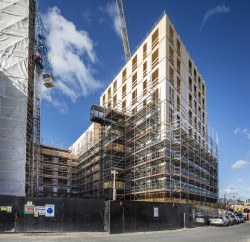Globally, the production of mass timber systems is increasing exponentially, driven largely by the need for more sustainable ways of delivering the built environment. Dr Robert Hairstans, Associate Professor at Edinburgh Napier University and Head of the Centre for Offsite Construction + Innovative Structures explains further.
Coinciding with this is also a worldwide shift to more construction activities being carried out offsite in factory environments, given the need for improved levels of construction productivity combined with technological advances that are being made, both mechanically and digitally. Mass timber slab and beam components can be brought together and combined with other materials offsite to form modular or volumetric units capable of being enhanced to a high level of factory finish which equate to turnkey solutions.
The mass timber family of products consists of various form of solid laminate timber systems. However, it is the panelised or slab forms of mass timber, primarily CLT, that have particularly ‘moved the needle’ for use and application of timber in construction given their capability to form whole building envelopes, often in combination with mass timber beam products (glue-laminated timber and laminated veneer lumber) and other construction materials in hybrid forms.
The exponential growth in use of CLT is driven not only by the environmental credentials of timber as a product, but also by the structural attributes of the panels ascertained from this process that allow timber to be used in building applications beyond normal limitations. Once fabricated, the mass timber product is normally cut to the required shape and size for the end application via CNC (computer numeric control) saws which have the capability of cutting in almost any direction with the precision necessary to form openings, services voids or acoustic performance-enhancing profiles.
To streamline these processes, the CNC operations will be linked to computer aided design (CAD) and computer aided manufacture (CAM) software. It is worth noting that this approach can also be utilised on NLT fabricated with aluminium nails. These offsite manufactured mass timber products can then either be shipped direct to site or formed into offsite volumetric modules that can be taken to a high level of finish with windows, doors, external cladding and internal linings and services included. Carbon Dynamic a company based in the Scottish Highlands, are currently deploying this approach in the delivery of student accommodation for the Dyson Institute for Technology.
The utilisation of mass timber products requires a change in design thinking particularly when the products are to be further formed to create full volumetric units with an enhanced level of finish. Designers need to take cognisance of the capabilities of the mass timber manufacturing process (dimensional compatibility, CNC cutting and routing capability) and follow-on production activities (factory lifting, allowable space, available tools and equipment) to create the volumetric system. In addition, the logistical arrangements, from both a transport and site access perspective, need to be taken in to account.
Information and communication technology (ICT) system integration; understanding the full parameters of design for manufacture and assembly (DfMA) as well as disassembly (DfMA+D) and ensuring an early design freeze are therefore of high importance in adding more value in the factory and ensuring successful project delivery. DfMA+D takes cognisance of end of life or change of use, such that the building components are demountable in the future for reconfiguration or alternative applications.
Going forward, digitisation and the emergence of integrated BIM platforms that facilitate the interoperability of software utilised during each stage of the mass timber production process can enhance the level of information that resides within the built asset with a digital thread. In theory, this can provide the capability of tracing the source material back to the forest and thereby inform the product’s overall environmental credentials. The use of virtual reality and augmented reality (VR/AR) will facilitate knowledge exchange for upskilling and early integration across the project team, as well as client and customer understanding for improved decision-making. In-situ, the performance of the unit and its interactions with its users can be monitored, creating a feedback loop for future product optimisation or maintenance.
To Continue reading this article please visit: Offsite Magazine









